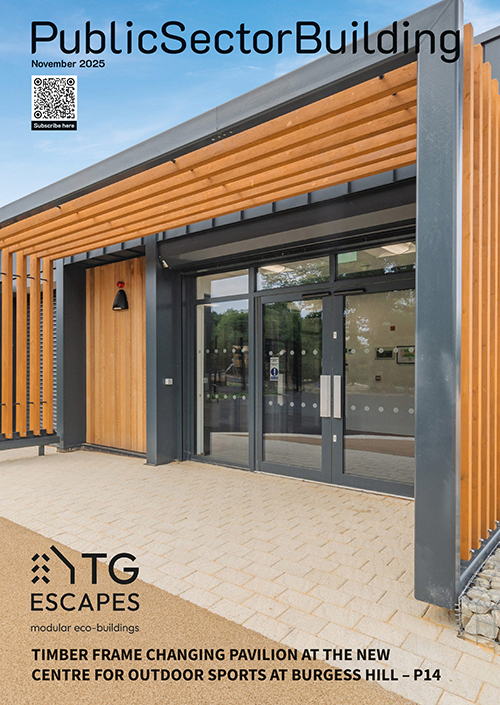The outstanding performance of cast iron in a fire is just one of the reasons why it is the material of choice for drainage systems in all high-rise residential and commercial buildings, explains Alumasc WMS…
On 5 July 2021, the government published the Building Safety Bill. This document makes the safety of occupants of high-rise buildings the responsibility of those who commission building work and who participate in the design and construction process.
The Bill is in response to Dame Judith Hackitt’s Independent Review of Building Regulations and Fire Safety, commissioned in the aftermath of the Grenfell Tower fire. It deals primarily with fire safety in high-rise residential buildings of 10 or more stories by ensuring safety is considered at every stage of a building’s lifetime.
Publication of the Bill will increase the focus on the selection of fire safe products, particularly the use of cast iron drainage systems, because of its proven outstanding performance in a fire.
One look at the product identification label printed in white lettering on the wall of any Harmer SML cast iron drainage pipe tells you all you need to know about the fire safety of the system.
Alongside the CE marking, BBA Agrément and Kitemark certification is the letter A and figure 2. This is the product’s Euroclass fire safety classification, its A2 designation shows that Alumasc’s Harmer SML system is classed as non-combustible because it will not contribute significantly to a fire.
Its outstanding fire performance is just one of Harmer SML’s many attributes that make it ideal for soil and rainwater systems in all buildings, and in tall buildings in particular.
Other advantages of cast iron include: its durability, its excellent acoustic performance and its impressive environmental credentials.

Drainage specifiers can take reassurance from the fact that cast iron systems are a proven technology having been in use for centuries. In that time systems have evolved so that today’s cast iron systems offer a lightweight, economical, functional, and robust solution for tall building soil & waste and rainwater drainage systems.
In addition, the quality of Harmer SML’s above and below ground cast iron pipes and fittings is assured through compliance with BS EN 877 and Agrément certification for above ground BS EN-12056-2 Code of practice for gravity drainage systems inside building-Sanitary pipework and BS EN-12056-3 For drainage of roofs. For the below ground system: BS EN-12056-1 For drain and sewer systems outside building.
To connect pipe sections, Harmer SML pipe couplings are available in either ductile iron or stainless steel to meet the requirements of BS EN 877. All couplings feature EPDM elastomeric seals as standard, with neoprene seals available on request.
Standard pipe couplings, fully secured and anchored, can usually withstand pressures of up to 5 bar. For applications where pressures can reach up to 16 bar, Harmer SML supply High Pressure Gripped Couplings, which are more than adequate for most building drainage systems.
Cast iron pipes are manufactured by pouring molten metal into a mould, which is then spun on its axis at high speed. Centrifugal force pushes the molten metal to the mould walls, which produces a casting that has uniform wall thickness and is denser and stronger than cast iron made using gravity alone.
This gives the pipe an inherent strength to ensures that if it is hit, either accidentally or otherwise, the pipe is unlikely to be damaged.
This inherent strength also means that cast iron pipes and fittings do not deform under load. Similarly, the metal’s rigidity and thermal stability ensures pipes are unaffected by temperature. In fact, the coefficient of thermal expansion of cast iron is low (at 0.0105mm/m/K), which is similar to that of concrete.
Its thermal stability means there is very little differential movement in pipe systems, so expansion joints are not generally needed, saving on both space and cost. By comparison HDPE systems often require multiple expansion joints to be installed, which may require additional space and supporting brackets to attach the system to the structure.
Another benefit of cast iron is that it remains serviceable over long periods of time. Harmer SML pipes and fittings incorporate a two-part epoxy coating on its internal surface and an anti-corrosive primer on the exterior, to ensure an installation will require minimal maintenance during its lifetime.
Its durability is what makes cast iron the ideal material for inaccessible and difficult to reach areas and for below-ground drainage, where its ability to resist chemical attack, degradation and ground movement are hugely beneficial.
Above ground, the excellent acoustic properties of Harmer SML means that additional sound protection is not normally required to protect against noise breakout from fluids flowing in the pipework.
This is important in all buildings and particularly so in high quality residential schemes, hospitals and high rise commercial. In addition, sound transmission through the structure is also ensure pipework is not in direct contact with the structure. In comparison, HDPE systems often require specialist acoustic pipework and/or additional sound insulation, which can add to both material and labour costs.
While there are many technical, ecological and financial reasons to consider cast iron drainage, by far the most compelling reason is the material’s superior performance in a fire.
Cast iron is non-combustible, making it ideal for installation where drainage pipework has to penetrate a wall or floor in fire compartment. Cast Iron has the added benefit of requiring simple, low-cost fire-stopping in the annular space between the pipe and structure.
In comparison, PVCu and HDPE pipework will require more expensive, high performing intumescent fire collars to be fitted to prevent fire breaching the compartment wall or floor when the plastic pipework inevitably melts.
It is reassuring to know that Harmer SML soil & waste and rainwater drainage systems have been rigorously tested and proven to achieve the highest possible fire rating under BS EN 13501 – the European standard for the fire classification of construction products.
The complete system is compliance tested, including the pipe connections with their elastomer gasket couplings as well as associated fittings and coatings.
The complete system has a Euroclass rating of A2-s1, d0. Its A2 classification means that Harmer SML is non-combustible; the S1 classification means that it has the lowest possible level for smoke emissions; while the d0 designation means the system does not produce flaming droplets.
Cast iron’s d0 flaming droplet classification is significant, cast Iron as a material unpainted is A1. In a fire, plastic pipework does melt, and the melted droplets can fall to initiate new fires.
Finally, in addition to its fire performance benefits, the environmental benefits of cast iron are increasingly being appreciated. Because it is extremely durable any installation will have a longer lifespan than an equivalent installation in plastic.
And, at the end of its (very long) life, cast iron is 100% recyclable which is good for the planet.




